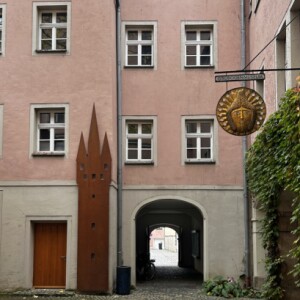Fascinating museum
Renata and I visited the Gaubodenmuseum, what a fascinating collection! We were expecting to see the collection of Roman treasures that were found in Straubing in 1950 but not all the other artifacts from centuries ago. The main photo is the sign hanging on the street and the extra is the entrance to o the museum. I tried to find a website in English about the museum but couldn’t, so I translated the German one and added it below for my information.
Another good day.
THE STRAUBINGER GÄUBODENMUSEUM
Not far from the town square is the Gäubodenmuseum in the Fraunhoferstraße. On the Danube, the millennia-old east-west connection, Straubing is located at an important connection to the Bohemian basin, the Cham-Further Senke. Location and richness of the soil ensure that the region has been continuously populated since 5600 BC. Thus, the Gäubodenmuseum, which looks back on a 175-year collection history in 2020, invites visitors to the former Herzogs and Wittelsbach government city to a walk through 7000 years of history of the city of Straubing and its surroundings.
The prehistoric department deals with the Straubinger area from the Neolithic period to the time of the Celts. Band ceramic tombs with their grave furnishings, made of Mediterranean mussels, the rich "Straubinger culture" (early bronze age metal hoards and costume equipment), a wooden fountain from the urn field era as well as evidence of the Celtic settlement refer to the culture dating back several millennia in and around Straubing.
This is followed by the department on the "Roman era", currently one of the largest of its kind in Bavaria. The masterpiece of international importance is the Roman treasure, the largest closed hard find of Roman parade armor ever. This is in the 3rd Century A.D. during the German raids or Civil wars and testifies to the splendor of the Roman Straubing with its face masks, leg splints, horse's foreheads, statuettes and everyday objects. Military history, civil settlement, religion, burial cult and agriculture illuminate the history of the place and its surroundings. The settlement can be completely reconstructed over late antiquity into the early Middle Ages.
In the immediate vicinity is the department "Baiers found", which opened in 2018. Designed interactively and handicapped according to the most modern standards, this section combines the historically significant finds from richly equipped necropolises of the early Middle Ages, which illustrate the early history of Bavarian. Thus, the finds from the Straubing-Bajuwarenstraße cemetery and not only give an impression of the handicrafts of that time, but also clues to the tribal formation of the Bajuwaren as well as the since the 9th century. developing city of Straubing.
The Bavarian department is followed by the departments "Sacral Art", "Popularity" and Urban History. Numerous aspects of the history of the Neustadt Straubing, which, founded in 1218 by Duke Ludwig the Kelheimer, quickly developed into an important administrative center of the Bavarian dukes and was developed into a residence on the Danube at the time of the Duchy of Straubing-Lower Bavaria-Holland (1353-1425). In addition to topics such as "religion in the curriculum vitae", "domestic devotion", "pilgrimage" or "customs of the dead", the departments convey to the visitors a cross-section of the rich artistic creation in and around Straubing from the Romanesque to the Rococo, the historical development of the former government city of Straubing up to the beginnings in the 20th century.


Comments
Sign in or get an account to comment.


